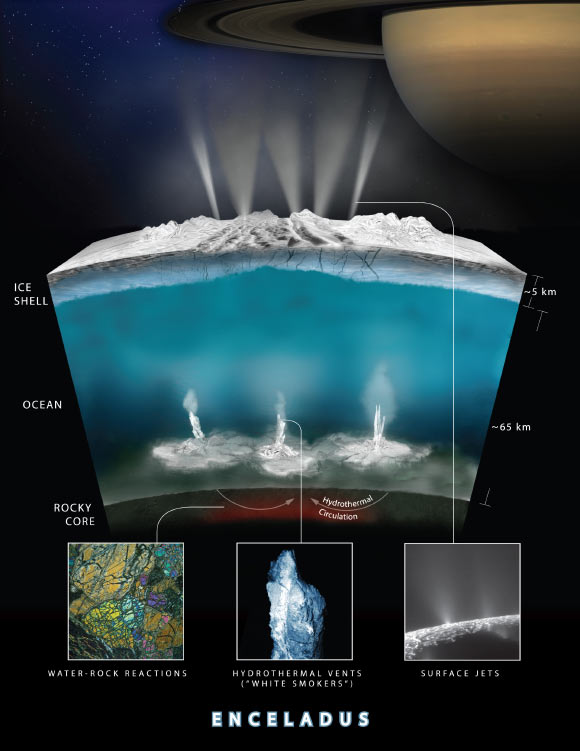Study: Active, Seafloor Hydrothermal Systems on Small Ocean Worlds Could Support Life

Top Stories Tamfitronics
Ocean worlds are planetary bodies that have a liquid ocean, often under an icy shell or within the rocky interior. In our own Solar System, several moons of Jupiter and Saturn are ocean worlds. Some ocean worlds are thought to have hydrothermal circulation, where water, rocks, and heat combine to drive fluids in and out of the seafloor. Hydrothermal circulation would impact the chemistry of the water and rock of ocean worlds, and could help life to develop deep below the icy surface. In a new study, planetary researchers used computer simulations of hydrothermal circulation, based on a well-understood system on Earth, to measure the influence of lower gravity at values appropriate for ocean worlds smaller than our home planet. The simulations with ocean world (lower) gravity result in fluid circulation much like that occurring on and below Earth’s seafloor, but with several important differences. Lower gravity reduces buoyancy, so fluids don’t become as light when heated, and this reduces flow rates. This can raise temperatures in the circulating fluid, which could allow more extensive chemical reactions, perhaps including those that sustain life.

This graphic illustrates how Cassini scientists think water interacts with rock at the bottom of Enceladus’ ocean, producing hydrogen gas. Image credit: NASA / JPL-Caltech / Southwest Research Institute.
Rock-heat-fluid systems were discovered on Earth’s seafloor in the 1970s, when scientists observed discharging fluids that carried heat, particles, and chemicals.
Many vent sites were surrounded by novel ecosystems, including specialized bacterial mats, red-and-white tubeworms, and heat-sensing shrimp.
In the new study, University of California, Santa Cruz’s Professor Andrew Fisher and colleagues used a complex computer model based on hydrothermal circulation as it occurs on Earth.
After changing variables like gravity, heat, rock properties and fluid-circulation depth, they found that hydrothermal vents could be sustained under a wide range of conditions.
If these kinds of flows occur on an ocean world, like Jupiter’s moon Europa, they could raise the odds that life exists there as well.
“This study suggests that low temperature — not too hot for life — hydrothermal systems could have been sustained on ocean worlds beyond Earth over timescales comparable to that required for life to take hold on Earth,” Professor Fisher said.
The seawater-circulation system that the researchers based their computer models on was found on a 3.5 million-year-old seafloor in the northwestern Pacific Ocean, east of the Juan de Fuca Ridge.
There, cool bottom water flows in through an extinct volcano (seamount), travels underground for about 30 miles (48.3 km), then flows back out into the ocean through another seamount.
“The water gathers heat as it flows and comes out warmer than when it flowed in, and with very different chemistry,” Kristin Dickerson, a Ph.D. candidate at the University of California, Santa Cruz.
“The flow from one seamount to another is driven by buoyancy, because water gets less dense as it warms, and more dense as it cools,” Professor Fisher added.
“Differences in density create differences in fluid pressure in the rock, and the system is sustained by the flows themselves — running as long as enough heat is supplied, and rock properties allow enough fluid circulation. We call it a hydrothermal siphon.”
“While high-temperature vent systems are driven mainly by sub-seafloor volcanic activity, a much larger volume of fluid flows in and out of Earth’s seafloor at lower temperatures, driven mainly by background cooling of the planet.”
“The flow of water through low-temperature venting is equivalent, in terms of the amount of water being discharged, to all of the rivers and streams on Earth, and is responsible for about a quarter of Earth’s heat loss.”
“The entire volume of the ocean is pumped in and out of the seafloor about every half-million years.”
Many previous studies of hydrothermal circulation on Europa and Enceladus have considered higher temperature fluids.
“Cartoons and other drawings often depict systems on their seafloors that look like black smokers on Earth. Lower-temperature flows are at least as likely to occur, if not more likely,” said Dr. Donna Blackman, also from the University of California, Santa Cruz.
The findings show that, under very low gravity — like that found on the seafloor of Enceladus — circulation can continue with low to moderate temperatures for millions or billions of years.
This could help to explain how small ocean worlds can have long-lived fluid-circulation systems below their seafloors, even though heating is limited: the low efficiency of heat extraction could lead to considerable longevity — essentially, throughout the life of the Solar System.
The scientists acknowledge the uncertainty of when the seafloors of ocean worlds will be directly observed for the presence of active hydrothermal systems.
Their distance from Earth and physical characteristics present major technical challenges for spacecraft missions.
“Thus, it is essential to make the most of available data, much of it collected remotely, and leverage understanding from decades of detailed studies of analog Earth systems,” the authors concluded.
Their paper was published in the Journal of Geophysical Research: Planets.
_____
A.T. Fisher et al. 2024. Sustaining Hydrothermal Circulation with Gravity Relevant to Ocean Worlds. Journal of Geophysical Research: Planets 129 (6): e2023JE008202; doi: 10.1029/2023JE008202



 Hot Deals
Hot Deals Shopfinish
Shopfinish Shop
Shop Appliances
Appliances Babies & Kids
Babies & Kids Best Selling
Best Selling Books
Books Consumer Electronics
Consumer Electronics Furniture
Furniture Home & Kitchen
Home & Kitchen Jewelry
Jewelry Luxury & Beauty
Luxury & Beauty Shoes
Shoes Training & Certifications
Training & Certifications Wears & Clothings
Wears & Clothings
















